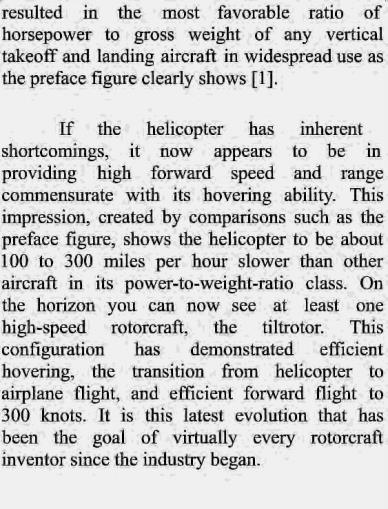
resulted in the most favorable ratio of horsepower to gross weight of any vertical takeoff and landing aircraft in widespread use as the preface figure clearly shows [1] If the helicopter has inherent shortcomings,it now appears to be in providing high forward speed and range commensurate with its hovering ability.This impression,created by comparisons such as the preface figure,shows the helicopter to be about 100 to 300 miles per hour slower than other aircraft in its power-to-weight-ratio class.On the horizon you can now see at least one high-speed rotorcraft,the tiltrotor.This configuration has demonstrated efficient hovering,the transition from helicopter to airplane flight,and efficient forward flight to 300 knots.It is this latest evolution that has been the goal of virtually every rotorcraft inventor since the industry began
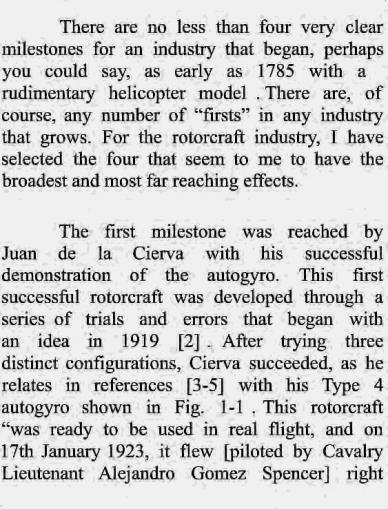
There are no less than four very clear milestones for an industry that began,perhaps you could say,as early as 1785 with a rudimentary helicopter model There are,of course,any number of“firsts”in any industry that grows.For the rotorcraft industry,I have selected the four that seem to me to have the broadest and most far reaching effects. The first milestone was reached by Juan de la Cierva with his successful demonstration of the autogyro.This first successful rotorcraft was developed through a series of trials and errors that began with an idea in 1919 [2].After trying three distinct configurations,Cierva succeeded,as he relates in references [3-5]with his Type 4 autogyro shown in Fig.1-1,This rotorcraft was ready to be used in real flight,and on 17th January 1923,it flew [piloted by Cavalry Lieutenant Alejandro Gomez Spencer]right
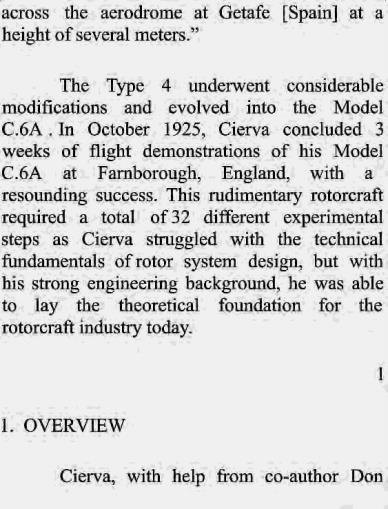
across the aerodrome at Getafe [Spain]at a height of several meters." The Type 4 underwent considerable modifications and evolved into the Model C.6A.In October 1925,Cierva concluded 3 weeks of flight demonstrations of his Model C.6A at Farnborough,England,with a resounding success.This rudimentary rotorcraft required a total of 32 different experimental steps as Cierva struggled with the technical fundamentals of rotor system design,but with his strong engineering background,he was able to lay the theoretical foundation for the rotorcraft industry today. OVERVIEW Cierva,with help from co-author Don
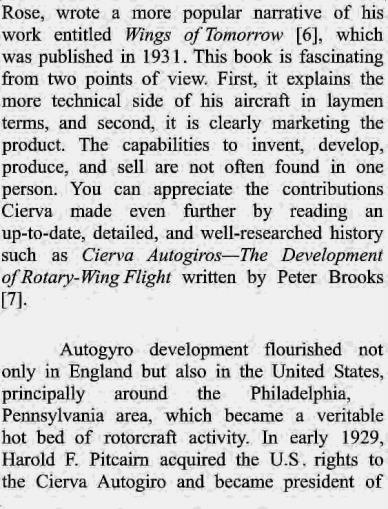
Rose,wrote a more popular narrative of his work entitled Wings of Tomorrow [6],which was published in 1931.This book is fascinating from two points of view.First,it explains the more technical side of his aircraft in laymen terms,and second,it is clearly marketing the product.The capabilities to invent,develop, produce,and sell are not often found in one person.You can appreciate the contributions Cierva made even further by reading an up-to-date,detailed,and well-researched history such as Cierva Autogiros-The Development of Rotary-Wing Flight written by Peter Brooks 7] Autogyro development flourished not only in England but also in the United States, principally around the Philadelphia, Pennsylvania area,which became a veritable hot bed of rotorcraft activity.In early 1929, Harold F.Pitcairn acquired the U.S.rights to the Cierva Autogiro and became president of
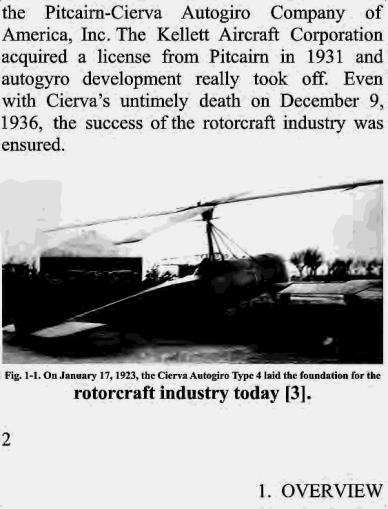
the Pitcairn-Cierva Autogiro Company of America,Inc.The Kellett Aircraft Corporation acquired a license from Pitcairn in 1931 and autogyro development really took off.Even with Cierva's untimely death on December 9, 1936,the success of the rotorcraft industry was ensured. Fig.1-1.On January 17,1923,the Cierva Autogiro Type 4 laid the foundation for the rotorcraft industry today [3]. 2 1.OVERVIEW